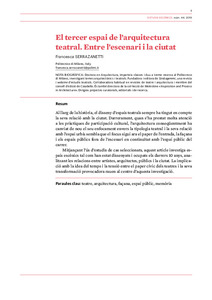El tercer espai de l’arquitectura teatral. Entre l’escenari i la ciutat
Metadata
Show full item record
Estudis escènics: quaderns de l'Institut del Teatre. 2019, Núm. 44
Document typeArticle
Abstract
<p>Al llarg de la història, el disseny d’espais teatrals sempre ha tingut en compte la seva relació amb la ciutat. Darrerament, quan s’ha prestat molta atenció a les pràctiques de participació cultural, l’arquitectura conseqüentment ha canviat de nou el seu enfocament envers la tipologia teatral i la seva relació amb l’espai urbà: sembla que el focus sigui ara el paper de l’entrada, la façana i els espais públics fora de l’escenari en continuïtat amb l’espai públic del carrer.</p>
<p>Mitjançant l’ús d’estudis de cas seleccionats, aquest article investiga espais escènics tal com han estat dissenyats i ocupats els darrers 10 anys, analitzant les relacions entre artistes, arquitectes, públics i la ciutat. La implicació amb la idea del temps i la tensió entre el paper cívic dels teatres i la seva transformació provocadora rauen al centre d’aquesta investigació.</p> <p>Theatre design has always looked, through history, to its relation with the city. Recently, when much attention has been paid to the practices of cultural participation, architecture has consequently again changed its approach to theatre typology and its relation with the public urban space: the focus seems to have moved to the role of the entrance, the façade and the public spaces outside the stage in continuity with the public space of the street.</p>
<p>Through the use of selected case studies, this article investigates theatre places as they have been designed and occupied in the last ten years by analysing the relations between artists, architects, audiences and the city. The engagement with the idea of time and the tension between theatres’ civic role and their provocative transformation are the core of this investigation.</p>
Access conditionsOpen Access
ISSN2385-362X
,
0212-3819
Collections
- 2019: Núm.: 44 [22]


